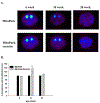Voluntary exercise delays progressive deterioration of markers of metabolism and behavior in a mouse model of Parkinson's disease
- PMID: 31226324
- PMCID: PMC6702069
- DOI: 10.1016/j.brainres.2019.146301
Voluntary exercise delays progressive deterioration of markers of metabolism and behavior in a mouse model of Parkinson's disease
Abstract
Although a good deal is known about the genetics and pathophysiology of Parkinson's disease (PD), and information is emerging about its cause, there are no pharmacological treatments shown to have a significant, sustained capacity to prevent or attenuate the ongoing neurodegenerative processes. However, there is accumulating clinical results to suggest that physical exercise is such a treatment, and studies of animal models of the dopamine (DA) deficiency associated with the motor symptoms of PD further support this hypothesis. Exercise is a non-pharmacological, economically practical, and sustainable intervention with little or no risk and with significant additional health benefits. In this study, we investigated the long-term effects of voluntary exercise on motor behavior and brain biochemistry in the transgenic MitoPark mouse PD model with progressive degeneration of the DA systems caused by DAT-driven deletion of the mitochondrial transcription factor TFAM in DA neurons. We found that voluntary exercise markedly improved behavioral function, including overall motor activity, narrow beam walking, and rotarod performance. There was also improvement of biochemical markers of nigrostriatal DA input. This was manifested by increased levels of DA measured by HPLC, and of the DA membrane transporter measured by PET. Moreover, exercise increased oxygen consumption and, by inference, ATP production via oxidative phosphorylation. Thus, exercise augmented aerobic mitochondrial oxidative metabolism vs glycolysis in the nigrostriatal system. We conclude that there are clear-cut physiological mechanisms for beneficial effects of exercise in PD.
Keywords: Dopamine; Exercise; Mitochondria; PET; Parkinson’s disease.
Copyright © 2019 The Authors. Published by Elsevier B.V. All rights reserved.
Conflict of interest statement
Conflict of Interest and Author Disclosure Statement
LO is a co-owner of a company that owns commercial rights to the MitoPark mouse. The other authors have no conflict of interest.
Figures






References
-
- Alonso-Frech F, Sanahuja JJ, and Rodriguez AM (2011). Exercise and physical therapy in early management of Parkinson disease. Neurologist 17, S47–53. - PubMed
-
- Betarbet R, Sherer TB, MacKenzie G, Garcia-Osuna M, Panov AV, and Greenamyre JT (2000). Chronic systemic pesticide exposure reproduces features of Parkinson’s disease. Nat Neurosci 3, 1301–1306. - PubMed
Publication types
MeSH terms
Substances
Grants and funding
LinkOut - more resources
Full Text Sources
Medical
Molecular Biology Databases

